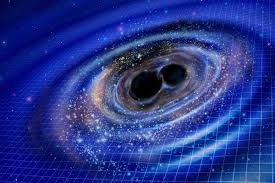Massive Black Hole Merger Observed:

An international team of scientists has detected the most massive black hole merger ever observed. The event, named GW231123, was observed by the LIGO-Virgo-KAGRA (LVK) collaboration, which forms the Gravitational Wave Network.
- A black hole merger occurs when two black holes orbit each other and gradually move closer by emitting gravitational waves (ripples in space-time caused by some of the most violent and energetic processes in the universe).
- As they spiral inward, they eventually collide and merge into a single, larger black hole.
- These gravitational waves are detected on Earth by observatories like the LVK network of gravitational wave observatories.
- It involved two black holes, approximately 100 and 140 times the mass of the Sun, colliding to form a single, massive black hole about 225 times the Sun’s mass.
- The waves from GW231123 actually originated billions of years ago, but only reached Earth in 2025.
- This black hole merger, unlike typical stellar black holes under 60 solar masses, GW231123 is much bigger and spinning unusually fast, making the discovery even more intriguing.
- Black holes this big are typically thought to come from the collapse of huge stars. This event suggests that some may instead form through mergers of smaller black holes.




